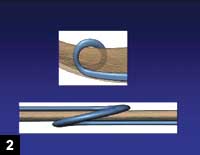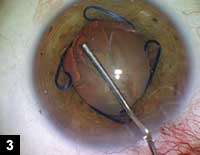Surgeon: Malyugin ring helpful in small-pupil phacoemulsification
The ring’s designer describes his surgical method for using the device in complicated phaco cases.
Introduction

To enhance phacoemulsification surgery in complicated small-pupil cases, Boris Malyugin, MD, PhD, of Russia designed a new device. It is used in cases of pupil miosis refractory to dilation protocols.
 Amar Agarwal |
The device is a square-shaped temporary implant with four circular loops that hold the iris at equidistant points (Figures 1 and 2). It has a one-piece design with curls at each angle of the ring that provide balanced stretching and gentle holding of the iris tissue. I consider this new device among the most effective methods for increasing the size of rigid small pupils during phaco. The use of this method is highly recommended, as it is likely to reduce postoperative abnormalities in pupil size and function.
My special guest in this column is Dr. Malyugin himself to explain more about his special ring, which is being manufactured by MicroSurgical Technology.
Amar Agarwal, MS, FRCS, FRCOphth
OSN Complications Consult Editor
The insertion of the Malyugin ring is carried out through the main incision with the help of an injector. The tip of the injector is inserted in the wound, and then the surgeon moves the thumb slide completely distal. The ring goes out of the injector at the same time that the distal scroll and two lateral scrolls engage the pupillary margin. After withdrawing the injector from the anterior chamber, the distal scroll is laying on the iris. A Lester hook or a similar hook is used to place the proximal scroll.
In cases of extremely small pupils, the Malyugin ring is positioned centrally in the anterior chamber on top of the iris, and then it is gently pushed at each angle with the help of a hook to trap the iris in the four curls one by one. Once in place, the ring expands the pupillary opening to 6 mm (Figure 3). The ring provides stable mydriasis with no trauma to the iris tissue and no need for additional paracenteses. It retracts the iris away from the flow currents and thus helps to prevent its incarceration into the ultrasound and irrigation and aspiration handpieces. As the result of the ring implantation, we obtain a square 6-mm pupil dilation that allows for safe and comfortable maneuvers during phacoemulsification.
A cadaver eye study using scanning electronic microscopy showed how much less damage to the pigmented iris tissue was caused by this new instrument than by conventional iris retractors (Figure 4).
|
|
|
|
|
Images: Agarwal A |
Ring removal
The ring is retracted from the anterior chamber through the clear corneal incision with the same injector device. Aspiration is performed to remove the residual ophthalmic viscosurgical device. After viscoelastic removal, the clear corneal incision is hydrated with balanced salt solution. At the completion of the case, the pupil constricts spontaneously.
Advantages
- The ring is as effective as conventional iris hooks. However, compared with other long-in-use iris retractors, it has the advantage of being friendlier with the eye due to the well-distributed stretching and gentle holding of the delicate iris tissue and to the easier and less traumatic implantation. It has no sharp or pointed endings that can damage the eye.
- Equidistant position of the loops that hold the iris tissue ensures correct position of the iris and prevents the effect of overstretching of the pupil observed in incorrect iris hooks position.
- The device is applying pressure to the sphincter muscle over an area that is wider than in cases of iris hooks. It is particularly useful in patients in which cutting or tearing of the iris tissue should be avoided, especially in the presence of rubeosis, chronic anterior uveitis or systemic coagulopathy. The iris rim is safely fixed in the loops of the ring, and there is no risk of iris aspiration during phacoemulsification.
- The ring does not require additional incisions. This instrument is inserted through the one main incision, thus reducing surgical trauma and minimizing the risk of contamination and postoperative inflammatory reaction.
- In floppy iris syndrome, the iris can prolapse through the wound. This is particularly true in patients with relatively wide paracenteses and extremely atonic and atrophic irises. The Malyugin ring has proven to be effective in achieving sufficient mydriasis and, at the same time, stabilizing the iris tissue in cases of intraoperative floppy iris syndrome.
- The ring provides sufficient room for nucleus fragmentation and removal. The device configuration allows surgeon to work in the deep lens layers below the iris plane and the square-shaped pupil formed by the ring. This provides enough space for grooving and cutting the nucleus and increased peripheral visualization during the chopping phase of the procedure.
- The ring is inserted and removed from the eye with a help of an injector, thus reducing the risk of contamination and the risk of disturbance of the incision architecture and wound integrity.
For More Information:
- Amar Agarwal, MS, FRCS, FRCOphth is director of Dr. Agarwal’s Group of Eye Hospitals. Prof. Agarwal is the author of several books published by SLACK, Incorporated, publisher of Ocular Surgery News, including Phaco Nightmares: Conquering Cataract Catastrophes, Bimanual Phaco: Mastering the Phakonit/MICS Technique, Dry Eye: A Practical Guide to Ocular Surface Disorders and Stem Cell Surgery, and Presbyopia: A Surgical Textbook. He can be reached at 19 Cathedral Road, Chennai 600 086, India; fax: 91-44-28115871; e-mail: dragarwal@vsnl.com; Web site: www.dragarwal.com.
- Boris Malyugin, MD, PhD, is the chief of the cataract and implant surgery department and deputy director general of the S. Fyodorov Eye Microsugery Complex State Institution, Beskudnikowsky Blvd. 59A, 127486 Moscow, Russia; 7-495-488-8511; fax: 7-495-905-8051; e-mail: malyugin@online.ru. Dr. Malyugin is a medical consultant for MicroSurgical Technology.
References:
- Agarwal A. Handbook of Ophthalmology. Thorofare, NJ: SLACK Incorporated; 2005.
- Agarwal S, Agarwal A, Agarwal A. Four volume textbook of ophthalmology. India: Jaypee; 2000.
- Agarwal A. Phaco Nightmares: Conquering Cataract Catastrophes. Thorofare, NJ; SLACK Incorporated; in press.
- Agarwal A, et al. Two volume textbook on phacoemulsification. India; Jaypee; 2004.
- Malyugin B. Small pupil phaco surgery: a new technique. Ann Ophthalmol. 2007;39(3):185-193.




